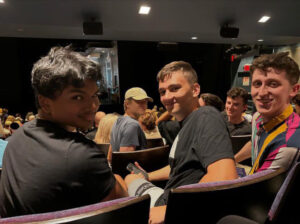 The Counter does a fantastic job of posing friendship as the answer to the question of why live. The world is lonely, tragic and even boring, but friendship is life-affirming and agentic.
The Counter does a fantastic job of posing friendship as the answer to the question of why live. The world is lonely, tragic and even boring, but friendship is life-affirming and agentic.
First, The Counter centers the viewer in a familiar setting to our own. Although in a rural town that differs from Staten Island’s suburban atmosphere, it is also an atomized world. Katie watches Netflix and goes on walks on her own. Life’s highlights are the movies and the grand opening of the new Whole Foods. The best part of Paul’s day is his conversation with the woman who serves him his morning coffee before a deep relationship even develops between them. It is telling that the characters are so removed from social institutions that their close relationships are with those who facilitate their consumption. That is because too often in the modern world, one’s identity is not built by human connection but by isolated consumption, whether of films or morning coffee. One might share their streaming site passwords with others, but the streaming itself is a secluded endeavor. It is simply not possible to share consumption, and so life remains solitary.
Friendship offers something substantive to share: one’s life. A true friend is the kind Paul describes towards the beginning of the play. A friend is a person who can be relied on and who can help one deal with life’s problems. This cliche definition is revealed to have tremendous utility in explaining the value of friendship. As Paul and Katie share their secrets with each other like some kind of teenage party game, they end up becoming each other’s backbones in their respective struggles trying to escape their lives. Paul had judged Katie for leaving her city life behind and Katie Paul’s adultery and suicidal ideation. However, they came to empathize with one another and comprehend why they each felt so desperate for an escape hatch. Furthermore, the play demonstrates that sharing lives involves not merely sympathetic spectating, but actively participating in each other’s lives. For instance, Katie encourages Paul to learn Italian and pursue his forbidden love. Additionally, the revelation of Katie’s hysterectomy pulls Paul off the edge because each was a stakeholder in the story of the other. However, the unparalleled instance which profoundly conveys that friendship entails being contributors to one another’s lives is when an exhilarated Paul pushes Katie to reunite with the guy who friendzoned her. He grabs her by the shoulders and effectively wills her out of the door of the cafe to go meet him. Katie trusts Paul because he has become her pillar, just as she has become his. The play’s ending thus imparts that the friendship bond-the sharing of a life-is not only one of mutual confidants and advisors, but active partners who help one another be the best versions of themselves.
Second, friendship is posited as a remedy for life’s tragic nature. The Counter claims life is tragic because of its inevitable calamities. This is indicated by Paul’s description of the powerlessness he feels in fending off aging and the grief which remains from the deaths of his close family members. As a result of this grim perspective, Paul views control over his own death as the only area where he can exert some measure of autonomy. In correspondence with this, Katie found herself paralyzed, in her case by illness and unforeseeable relationship issues. She seeks to control her own destiny by exercising her freedom to escape. Escape is conceived of as the one choice people are left with during an unmanageable catastrophe. Yet, escape is an anti-social choice. It is clear how that is true of suicide. The extreme ghosting Katie engages in-the moving seven hours away kind of ghosting-is also an attempt to break loose from social connection. Although she is fleeing the discomfort that comes with being friendzoned, a fundamental part of relationships is that they don’t always turn out how one expects.There is another person involved after all. Thus, Katie’s ghosting is an escape from discomfiture which is intrinsic to mutual social connection.
As opposed to escape’s disengagement from others, friendship rectifies a part of life’s pains in one simple sense because it provides a shoulder to cry on. Paul details how he is tired of hearing shallow remarks of comfort as he walks in the street. He despises Peg’s pity. Pity is the surface-level sadness one expresses at the misfortune of another. True friendship means empathy, which is suffering with another person-not expressing heartache at another’s pain in a way which makes them feel inferior. For instance, a friend’s empathy is how Katie divulges her secret illness history. She displays that she feels compelled enough by the pain of Paul’s story to share her own with him.
A second more complex way that friendship resolves the inherent tragedy of life is that it provides a measure of dignity. Paul hates pity because it robs him of his self-respect. Friendship not only provides compassion which doesn’t demean a person, but is a mechanism for autonomy, which produces pride. Unlike the great careers and life partners Paul had waited for, Paul consciously chooses to open himself up and court the friendship of Katie. He makes a move at the counter and admits he isn’t happy being an acquaintance. Friendship cannot be accomplished by idleness. It requires people to break the ice and continually reinvest their energy into caring about one another. A true friendship is something which requires taking responsibility and making a continuous commitment to prioritize the relationship. Paul is a little shocked that Katie is upset about his being sick for a day. However, he shouldn’t be. She is his friend and in being such, had taken on the mantle of overseeing his well-being. One lesson of Paul and Katie’s relationship is that the fundamental ennobling choice of one’s life is whether one takes a deep interest in the lives of the people around them.
Third, The Counter asserts that friendship infuses life with novelty. This is because people get bored of themselves. On one occasion, Paul laments that he has gotten the gist of life’s monotonous routine. On another, he says that if he doesn’t sleep, he just talks to himself for hours. Arguably, Paul finds life dull because nearly all of his life is spent talking to himself. His life is only kept stimulating because he has another person in Katie-whose mind he does not have access to-with whom to share his thoughts. Even Paul’s hobby of learning Italian is intrinsically communicative. Since he is not going to Italy, the value he gains from the pastime comes from speaking to Katie in Italian.
Friendship is gripping because there is usually always something to learn about one’s friend. Even when one thinks they have learned it all, built-in to human relations is that two minds cannot see each other’s thoughts. As long as there is no telepathy, human beings will be forced to face one unknown, which is the other. The whole reason why Paul and Katie-why any human beings for that matter-can have a back and forth dialogue where they have “fights” and not gauge each other’s responses is because they are of separate minds. This trait gives friendships dynamism, which comes with both instability and innovation. Paul is looking for “surprise” which is why he would like Katie to decide when to kill him. He can’t access the thought process of a friend and as a result, Katie being given discretion means he wouldn’t know when his death is coming. Paul was banking on the precariousness of friendship. Sometimes people freak out and overreact to things. If Katie were to kill him, it would be because she had lost her mind. As Paul says, people do that on occasion. Instead, Paul discovers that friendship can produce an optimistic form of surprise-the unexpected progress of a friend. At the end of the play, Katie’s situationship comes to meet her in town. Paul is enlivened by the new developments in her relationship and the potential for her to not only connect with a great guy but repair what has broken her for years. Katie declares this series of events the “surprise” Paul had been looking for. That is because friendship brings constant newness. Friendship provides the potential for one’s companion to unpredictably alter their circumstances and thought processes. Personal change is premeditated, but constructive change in a friend’s life is something one only catches glimpses of when it is shared with them. Paul got in on the ground floor of bettering a friend’s life, which is the exact kind of new modulation he ached for.
One could come away from The Counter feeling depressed. The play explores the idea that all people are in a sense waiting for the aging process and death to rob them of everything they ever had or loved. In fact, it is helpful to conceive of life as waiting in a waiting room. There is nothing more soulless than that. One may skim through magazines, but they provide nothing of substance. Additionally, the strangers one sits across from may curl their lips into a semi-smile for a moment but they will immediately retreat into their own distant world. To top it all off, one is impotent in speeding up what feels like an endless process. The Counter asks one to imagine that a close friend has walked into this waiting room. The atmosphere changes completely. In addition to fixing the loneliness of not having someone to delay life with, the presence of a buddy actually ends the eventless interlude. First, speaking with a friend ends the tyranny of the staff who usher in the next appointment. One partakes actively in friendship rather than being idle and letting the outside world dictate one’s “waiting room” experience. This agency is paramount to a joyful life. Additionally, whereas one had lacked spirit, one gains seemingly limitless energy. This is because a person is no longer imprisoned with their own thoughts. Instead, one has surprises at their fingertips in the form of hearing about their friend’s experiences and living through this new experience together. This is how a single friend can transform the gray paint on the walls of the doctor’s office waiting room into a vibrant rainbow. The Counter expresses that friendship makes life worth living because it stops the lonely, feebling and insipid waiting in its tracks. Katie was Paul’s waitress. By the end of the show, she is his friend.
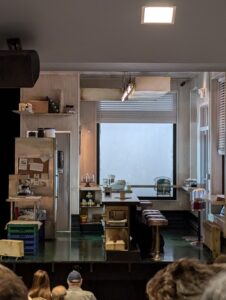
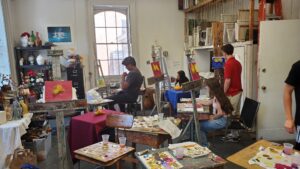 After that the class was handed a canvas, a plastic cup with a paint dissolving solution in it, a paintbrush, a wooden board with paper on it, and paper towels. Then I had a choice of what to paint and I
After that the class was handed a canvas, a plastic cup with a paint dissolving solution in it, a paintbrush, a wooden board with paper on it, and paper towels. Then I had a choice of what to paint and I 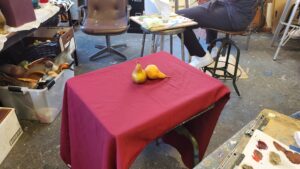 In order to do this, I needed to dip my brush into the paint dissolving solution then the light-blue oil paint. Then I began mixing colors to match the color of the first pear, which was a brownish-green, a yellowish-green, and a light-green color. After a couple of attempts, I finally made the desired colors and colored inside and a bit over the light-blue outline. Then I moved onto the next pear, which had a yellow-brown and yellow-green colo
In order to do this, I needed to dip my brush into the paint dissolving solution then the light-blue oil paint. Then I began mixing colors to match the color of the first pear, which was a brownish-green, a yellowish-green, and a light-green color. After a couple of attempts, I finally made the desired colors and colored inside and a bit over the light-blue outline. Then I moved onto the next pear, which had a yellow-brown and yellow-green colo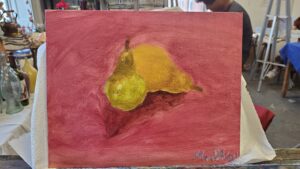 With the main details of the painting done, I went on to create the shadows, which was just a darker version of the original color. Finally, I created the stems of the pears and finished. The teacher told me that the painting will take a week to dry and to keep dust off of it. I took my artwork and went home.
With the main details of the painting done, I went on to create the shadows, which was just a darker version of the original color. Finally, I created the stems of the pears and finished. The teacher told me that the painting will take a week to dry and to keep dust off of it. I took my artwork and went home. 
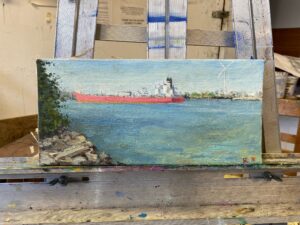

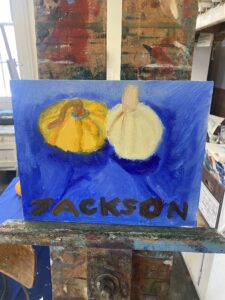
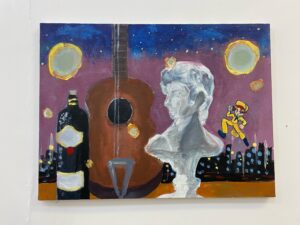

 The Counter
The Counter
